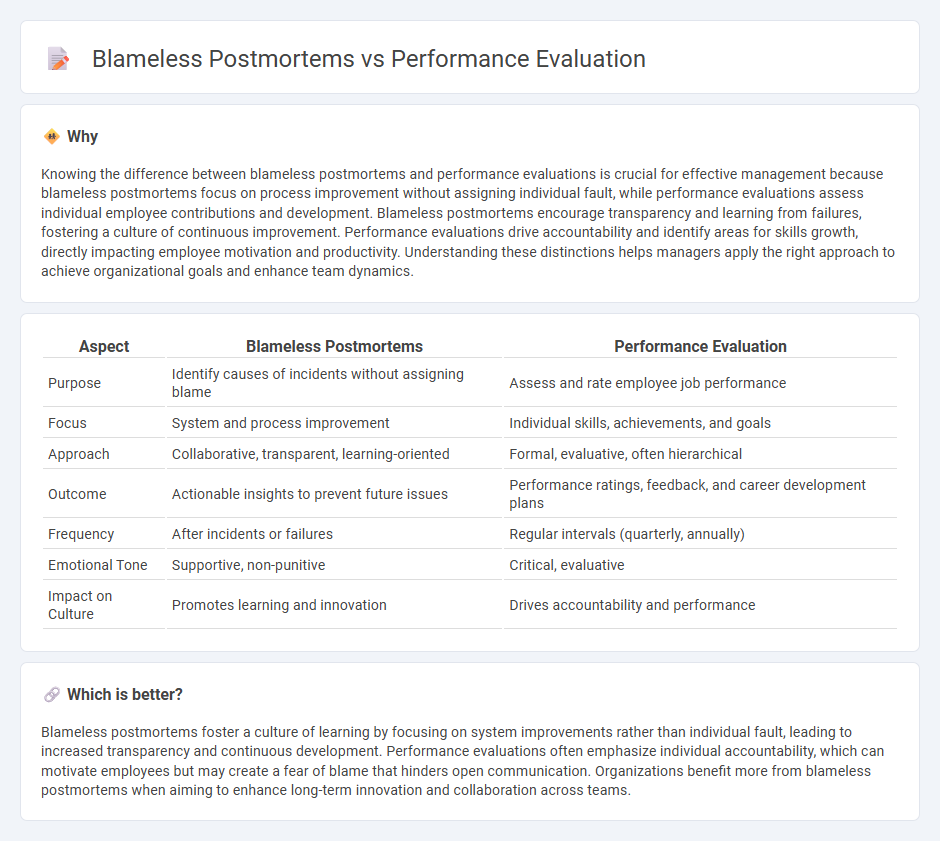
Blameless postmortems focus on analyzing failures without assigning personal blame, fostering a culture of continuous learning and transparency within teams. Performance evaluations emphasize individual achievements and areas for improvement, contributing to personal growth and organizational development. Explore the distinct approaches and benefits of both methods to enhance your management practices.
Why it is important
Knowing the difference between blameless postmortems and performance evaluations is crucial for effective management because blameless postmortems focus on process improvement without assigning individual fault, while performance evaluations assess individual employee contributions and development. Blameless postmortems encourage transparency and learning from failures, fostering a culture of continuous improvement. Performance evaluations drive accountability and identify areas for skills growth, directly impacting employee motivation and productivity. Understanding these distinctions helps managers apply the right approach to achieve organizational goals and enhance team dynamics.
Comparison Table
| Aspect | Blameless Postmortems | Performance Evaluation |
|---|---|---|
| Purpose | Identify causes of incidents without assigning blame | Assess and rate employee job performance |
| Focus | System and process improvement | Individual skills, achievements, and goals |
| Approach | Collaborative, transparent, learning-oriented | Formal, evaluative, often hierarchical |
| Outcome | Actionable insights to prevent future issues | Performance ratings, feedback, and career development plans |
| Frequency | After incidents or failures | Regular intervals (quarterly, annually) |
| Emotional Tone | Supportive, non-punitive | Critical, evaluative |
| Impact on Culture | Promotes learning and innovation | Drives accountability and performance |
Which is better?
Blameless postmortems foster a culture of learning by focusing on system improvements rather than individual fault, leading to increased transparency and continuous development. Performance evaluations often emphasize individual accountability, which can motivate employees but may create a fear of blame that hinders open communication. Organizations benefit more from blameless postmortems when aiming to enhance long-term innovation and collaboration across teams.
Connection
Blameless postmortems promote a culture of transparency and continuous improvement by focusing on systemic issues rather than individual faults, which directly informs more objective and constructive performance evaluations. This approach encourages honest feedback and learning opportunities, enabling managers to assess employee contributions based on growth and problem-solving skills rather than assigning blame. Integrating blameless postmortems into performance management fosters a supportive environment that drives accountability and team resilience.
Key Terms
Accountability
Performance evaluations measure individual accountability by assessing accomplishments and areas for improvement, fostering professional growth. Blameless postmortems emphasize system accountability by analyzing failures without attributing fault, promoting a culture of learning and continuous improvement. Explore how integrating both approaches can enhance organizational accountability and drive success.
Continuous Improvement
Performance evaluation focuses on individual or team achievements against predefined goals, often emphasizing accountability and areas for growth, while blameless postmortems concentrate on analyzing incidents without assigning fault to foster a culture of trust and continuous learning. Both methods contribute to continuous improvement by identifying gaps and enabling actionable insights but approach feedback and problem-solving from different angles--performance evaluations prioritize development plans, whereas blameless postmortems prioritize systemic changes and psychological safety. Discover more about integrating these approaches to enhance organizational resilience and growth.
Root Cause Analysis
Performance evaluation centers on assessing individual or team achievements against predefined goals, emphasizing metrics like productivity, efficiency, and goal fulfillment. Blameless postmortems prioritize identifying root causes of failures within systems or processes without assigning individual blame, fostering a culture of continuous improvement and psychological safety. Explore detailed methodologies and benefits of both approaches to enhance organizational effectiveness.
Source and External Links
Employee Performance review phrases (1000+ phrases) - This resource provides detailed examples of performance review phrases to assess productivity and quality of work, categorizing performance as meeting or exceeding expectations versus below expectations.
Effective Employee Performance Evaluation: Best Practices - Explains the importance of setting clear, measurable goals collaboratively for effective performance evaluations that focus on growth potential and alignment with business objectives.
What Is Performance Evaluation? Types & Examples - Describes the step-by-step process of performance evaluations including periodic tracking, manager assessments, and integrating employee feedback through surveys and meetings.
 dowidth.com
dowidth.com